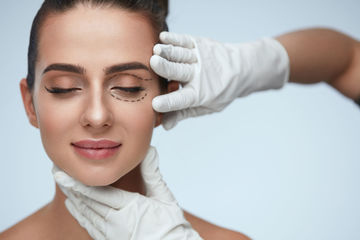Blepharoplasty (Eyelid surgery)
When is eyelid surgery useful?
The eyes are the window to the soul. During our lifetime, there is a relaxation of the eyelids. The elasticity of the skin diminishes and an excess of skin can occur on the upper and lower eyelids. Furthermore, fatty deposits, mainly on the lower lids cause “bags” to appear under the eyes and the lid muscles to sag. When an excessive amount of skin develops on the upper eyelids (hooded eyes), there is often a deterioration of the visual field but can be easily remedied by a blepharoplasty.
What is the aim of eyelid surgery?
The aim of the blepharoplasty, or eyelid surgery, is to remove the excess skin on the lids and the excess fat deposits (eye bags) to once again give the eyes more appeal.
Procedure. An incision is made in the natural folds of skin on the upper eyelid along the palpebral fold, parallel to the lid edges. It can, depending on the amount of excess skin, be slightly longer than the outline of the eye and it is sometimes also necessary to tighten the underlying muscle. Thereafter, the incision is closed with fine stitches. Depending on the severity, both upper and lower eyelid reductions can be combined together as described above.
Type of anaesthesia. This procedure is usually carried out under general anaesthetic but can also be carried out under local anaesthetic and sedation.
Whad do I have to consider before eyelid surgery (pre-operative phase)?
On the day of the operation please do not apply any make up or use any face or eye cream. Contact lenses should not be worn and left at home and it is advised that you bring a pair of dark sunglasses with you.
Information on general measures and the necessary preliminary examinations will be put together for you personally in a pamphlet which you will receive at your consultation.
Whad do I have to consider after eyelid surgery (post-operative phase)?
Recovery. After the operation it is absolutely necessary to sleep with the upper body elevated, not to bend down and to avoid physical exertion and strain. Temporary bruising, swelling or a feeling of tension in the face regularly occurs after surgery but these changes should not worry you and should disappear within a few days. Sometimes there can be oversensitivity to bright lights and drafts and therefore you may find it more comfortable to wear dark sunglasses for the first few days after surgery. Ice packs or cold compresses and lymph drainage, in consultation with your surgeon, may accelerate the reduction of swelling.
The fine stitches are generally removed 4-5 days after surgery and the applying of make-up is once again possible one week after surgery. A slight loss of sensation in the eyelid skin may be present for several weeks, but this should return to normal. Strenuous physical activity and sports should be avoided for 4 to 6 weeks. Heat from external sources (such as a sauna) should be avoided for 2 months and sun protection is necessary until all bruising has disappeared and until all scars have healed.
What are the possible risks with eyelid surgery?
No procedure is without risk. The general risks of surgery include the possibility of bleeding, thrombosis and infection and specifically with eye lid surgery there is a risk of temporary irritation of the conjunctiva which can cause the edge of the lower eyelid to stick out as well as a disturbance to the tear flow.
Which result can I expect after eyelid surgery and what are the chances of success?
Beautiful, radiant eyes. After the surgery your eyes will radiate freshness and vigour and will look more youthful and dynamic. The final result can be assessed after approximately 2 to 3 months.




